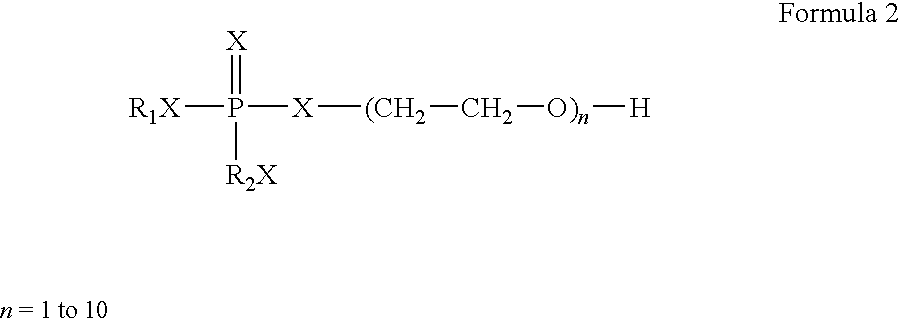Novel additive for naphthenic acid corrosion inhibition and method of using the same
a naphthenic acid and additive technology, applied in the direction of distillation corrosion inhibition, other chemical processes, fuels, etc., can solve the problems of corroding equipment used to distill, damage to piping and other associated equipment, and particularly severe corrosion in atmospheric and vacuum distillation units, so as to achieve the effect of effective naphthenic inhibitor and low acid valu
- Summary
- Abstract
- Description
- Claims
- Application Information
AI Technical Summary
Benefits of technology
Problems solved by technology
Method used
Image
Examples
example 1
Synthesis of Polymeric Organophosphorous Sulphur Compound—Additive Compound A
[0075]The weighed quantities of 68.16 gm of commercially available HRPIB (High Reactive Polyisobutylene with molecular weight 950 approximately), 30.31 gm of Phosphorous Pentasulphide and 1.51 gm of Sulphur Powder are charged into a clean four necked round bottom flask, equipped with N2 inlet, stirrer and thermometer, thereby forming a reaction mixture. This gives 1:1 mole ratio of Phosphorous Pentasulphide to Olefin.
[0076]The reaction mixture was stirred and heated to 160° C. temperature under nitrogen gas purging. The purging of N2 gas led to removal of hydrogen sulphide gas, which was generated during the reaction. The temperature of the reaction mixture was maintained between 160° C. to 180° C., for a period of 1 hour to 2 hours. Then the temperature of the mixture was raised to 220° C. and the mixture was maintained at this temperature for 6 to 10 hours.
example 2
Synthesis of Additive Compound C1 and Napthenic Acid Corrosion Inhibition Efficiency Testing of Additive Compound (A+C1) Using Static Test Method
[0080]The clean four-necked-flask was equipped with stirrer, nitrogen gas inlet and condenser. N-noctanol weighing 400 gms was charged, in the flask. The phosphorous pentasulphide weighing 187 gms, was then added to the flask in installments. The temperature of the flask was then increased to 110° C. The H2S gas was seen to be evolved after addition of P2S5. After one hour, the reaction mixture in the flask was heated to 140° C. and the flask was maintained at that temperature for one hour. The acid value of the reaction mixture was about 125 mg / KOH. The reaction mixture that is compound B1 was then transferred to the autoclave, and ethylene oxide was added till the pressure remained constant, thereby indicating no further absorption of the ethylene oxide by the reaction mixture. The system was then purged with nitrogen gas to remove the ex...
example 3
Synthesis of Additive Compound B2 and Naphthenic Acid Corrosion Inhibition Efficiency Testing of Additive Compound (A+B2) Using Static Test Method
[0081]The clean four-necked-flask was equipped with stirrer, nitrogen gas inlet and condenser. N-noctanol weighing 400 gms was charged in the flask. Phosphorous pentasulphide weighing 187 gms, was then added to the flask in installments. The temperature of the flask was then increased to 110° C. The H2S gas was seen to be evolved after addition of P2S5. After one hour, the reaction mixture in the flask was heated to 140° C. and the flask was maintained at that temperature for one hour. The sample was cooled and filtered through 5 micron filter. The sample was heated to 90° C. The nitrogen gas was purged for 5 hours. The resulting sample, that is compound B2 was analyzed for its acid value, which was found to be between 110 to 130 mg / KOH. The compound B2 was tested for its naphthenic acid corrosion efficiency. The efficiency of the combinat...
PUM
| Property | Measurement | Unit |
|---|---|---|
| Temperature | aaaaa | aaaaa |
| Temperature | aaaaa | aaaaa |
| Temperature | aaaaa | aaaaa |
Abstract
Description
Claims
Application Information
 Login to View More
Login to View More - R&D
- Intellectual Property
- Life Sciences
- Materials
- Tech Scout
- Unparalleled Data Quality
- Higher Quality Content
- 60% Fewer Hallucinations
Browse by: Latest US Patents, China's latest patents, Technical Efficacy Thesaurus, Application Domain, Technology Topic, Popular Technical Reports.
© 2025 PatSnap. All rights reserved.Legal|Privacy policy|Modern Slavery Act Transparency Statement|Sitemap|About US| Contact US: help@patsnap.com



